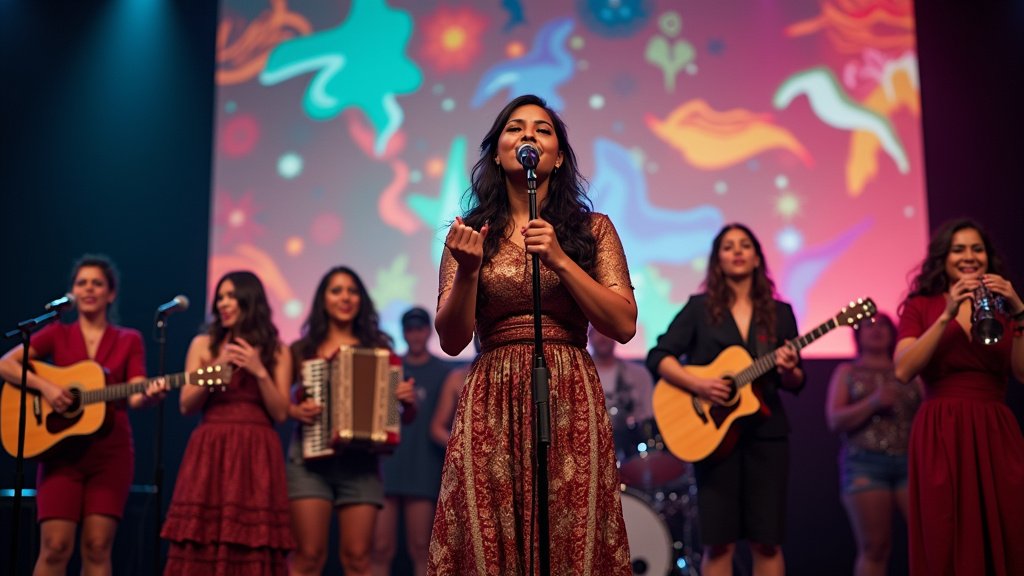The vibrant sounds of Women Mexican Music, a genre once confined to specific cultural enclaves, have exploded onto the global stage, propelled by streaming platforms and a new generation of artists. While this surge has cemented the dominance of Latin music in international charts, a parallel narrative of struggle and ascent is unfolding as women in Women Mexican Music demand their rightful place. For decades, these powerful musical traditions – from the robust brass of banda music to the emotive strumming of mariachi and the contemporary beats of corridos tumbados – have been largely male-dominated spaces. Now, female artists are challenging this status quo, injecting fresh perspectives and reclaiming the narrative within Women Mexican Music, showcasing the incredible talent of female regional mexican artists and contributing to the global mexican music scene. The increasing presence of women in mexican music is a testament to their evolving role.
A Genre’s Global Domination and the Rise of Women Mexican Music
The recent international breakthrough of Mexican regional music is undeniable. Artists like Peso Pluma and Natanael Cano have become household names, their corridos tumbados blending traditional Mexican folk elements with hip-hop and trap influences, capturing the attention of a worldwide audience. This phenomenon has contributed significantly to the broader success of Latin music, making it a dominant force in the global music landscape. The accessibility provided by digital platforms has been instrumental, allowing these regional sounds to reach listeners far beyond Mexico’s borders, creating a fertile ground for new talent and diverse expressions, including exciting new Women Mexican Music. This expansion highlights current latin music trends.
Historical Underrepresentation and Persistent Barriers for Women in Mexican Music
Despite the genre’s rich history, women have historically faced significant hurdles in gaining widespread recognition within Mexican regional music. While female artists have carved out spaces in other Latin genres, regional music has been slower to achieve gender parity. Traditional gender roles and music industry barriers have often limited opportunities, pushing female voices to the periphery or confining them to specific, often romanticized, subgenres. The expectation has frequently been for women to embody certain archetypes, rather than express the full spectrum of their experiences and artistic vision in Women Mexican Music, a challenge that banda music female artists are actively confronting. The journey for women in mexican music has been arduous.
Emerging Voices in Women Mexican Music and New Narratives
Today, a new wave of female artists is actively dismantling these barriers and forging their own paths within Women Mexican Music. They are not just seeking representation; they are actively creating music that speaks to their unique realities. These artists are exploring themes that resonate deeply with contemporary women, addressing love, heartbreak, resilience, empowerment, and social issues from a distinctly female perspective. Their music often incorporates contemporary sounds while staying true to the soulful roots of regional Mexican traditions. This artistic evolution is crucial for the genre’s continued growth and authenticity, reflecting the diverse voices that make up its audience in Women Mexican Music, and is a key part of current latin music trends. The rise of emerging female artists is reshaping the landscape of Women Mexican Music.
Industry Insights and Future Prospects for Women Mexican Music
Leila Cobo, Billboard’s chief content officer for Latin music, has highlighted the significant opportunity for women in this evolving landscape. She notes that while women are still navigating their way into these traditionally male-dominated spaces, their potential to lead is immense, particularly in the realm of Women Mexican Music. The current momentum suggests a shift is underway, with record labels, promoters, and audiences increasingly open to female artistry. The success of these emerging artists not only paves the way for future generations but also enriches the tapestry of Mexican regional music, making it more inclusive and reflective of its diverse creators. As these artists continue to push boundaries, they are authoring some of the most compelling stories in the contemporary latin music industry, ensuring their voices in Women Mexican Music are not just heard, but celebrated as top contenders in the global arena, contributing to the growing global mexican music scene. The dedication of women in mexican music is driving this progress.
The ongoing demand for representation is transforming Mexican regional music, promising a future where its global appeal is matched by its internal diversity and inclusivity. It is a testament to the resilience and creativity of women who are determined to leave their indelible mark on a genre they have long enriched, albeit often in the shadows of the music industry barriers. The world is listening, and their voices in Women Mexican Music are finally taking center stage, demonstrating the power of gender equality in music. The impact of corridos tumbados women is also becoming increasingly significant.

























